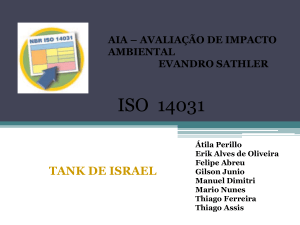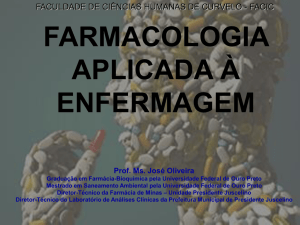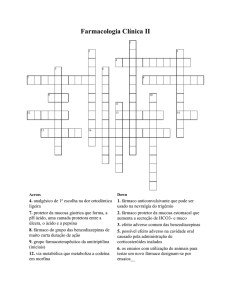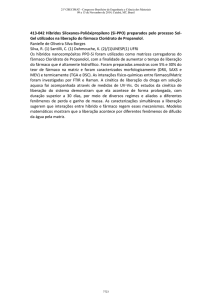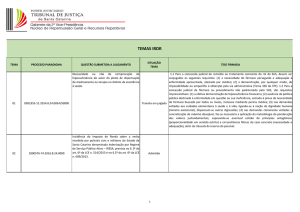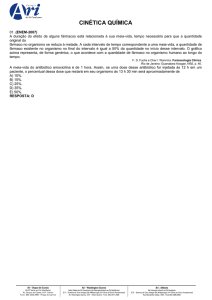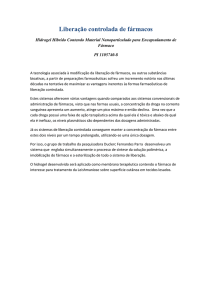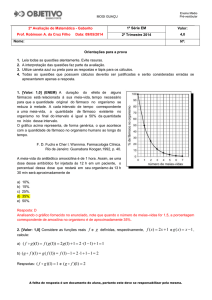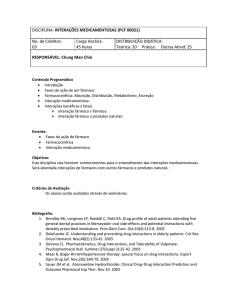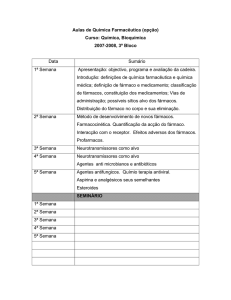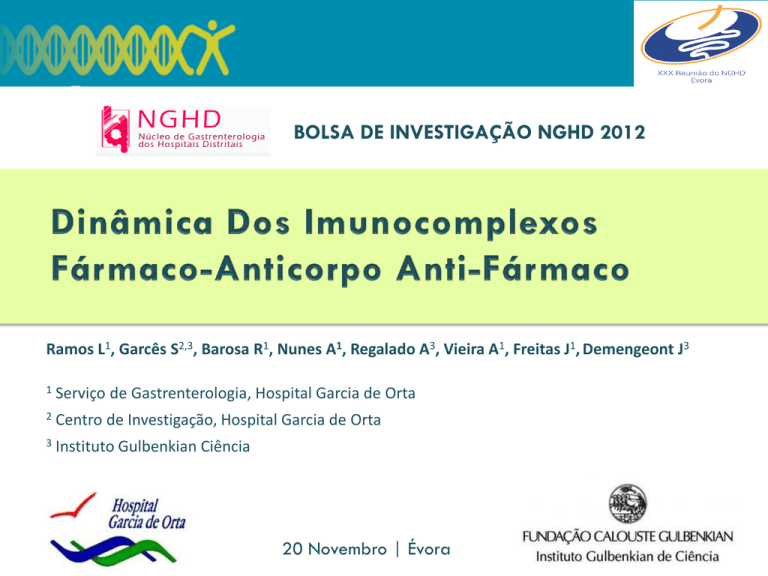
BOLSA DE INVESTIGAÇÃO NGHD 2012
Ramos L1, Garcês S2,3, Barosa R1, Nunes A1, Regalado A3, Vieira A1, Freitas J1, Demengeont J3
1
Serviço de Gastrenterologia, Hospital Garcia de Orta
2
Centro de Investigação, Hospital Garcia de Orta
3
Instituto Gulbenkian Ciência
20 Novembro | Évora
ANTI-TNFα
Perda de resposta
Reações adversas
Custos
Remissão livre corticoterapia
Redução internamentos
Redução cirurgias
Baert F et al. New England Journal of Medicine, 2003.
Ben-Horin S, Chowers Y. Nature Reviews Gastroenterology and Hepatology, 2014
Moss AC, Gastroenterology Report, 2015
Garcês S et al. Ann Rheum Dis 2012
IMUNOGENICIDADE
A
D
AB
Dinâmica entre fármaco e ADAb
ADAb
Fármaco
EXCESSO FÁRMACO
- Fármaco livre
- 0 ADAb livre
FÁRMACO-ADAb EM IC
- 0 Fármaco livre
- 0 ADAb livre
EXCESSO ADAb
- 0 Fármaco livre
- ADAb livre
• Os ensaios mais comuns não conseguem detectar ADAb em complexo com o fármaco
(Enzyme Linked ImmunoSorbent Assay, RadioImmunoAssay)
ADAb – Anticorpos anti-fármaco.
Vaughn BP t al.. Inf Bowel Disease, 2015
Hart M et al. J Immunol Methods 2012
Qual a relevância clínica dos ADA totais?
① Avaliar a farmacocinética do anti-TNFα durante o intervalo
entre 2 administrações.
① Avaliar a presença de ADA livres e totais entre 2
administrações e o seu impacto nos níveis de anti-TNFα.
Aprovado pela Comissão de Ética da Instituição
DESENHO DO ESTUDO
Apoio da Bolsa de Investigação NGHD 2012
Prospectivo, exploratório, observacional
POPULAÇÃO
Adultos (≥18 anos)
AMOSTRAS
Doença Inflamatória Intestinal
Sangue periférico
Sob infliximab
- Antes da administração fármaco
Seguidos em Hospital de Dia
- Semanal
S0
S1
Administração
S2
S3
S4
S5
S6 S7
S8
Administração
Características Demográficas Da População n=22
Tipo de DII (N (%))
Doença de Crohn 17 (77)
Localização (N (%))
Ileal (L1)
Cólica (L2)
Ileocólica (L3)
L1 + TGI superior (L4)
L3 + L4
Comportamento (N (%))
Perianal (N (%))
Inflamatório (B1)
Estenosante (B2)
Penetrante (B3)
B2B3
Colite Ulcerosa 5 (23)
2 (12)
3 (18)
10 (59)
1 (6)
1 (6)
6 (35)
3 (18)
3 (18)
5 (29)
Colite esquerda (E2)
Colite extensa (E3)
Total 22 (100)
3 (60)
2 (40)
-
Corticodependente 5 (100)
-
7 (41)
1 (20)
8 (36)
29 (14-47)
47 (29-59)
31 (14 – 59)
Género masculino (N (%))
6 (35)
1 (20)
7 (32)
Naives biológicos (N (%))
16 (94)
5 (100)
22 (100)
Imunomoduladores (N (%))
14 (82)
2 (40)
16 (73)
Duração doença – 1ªIFX2
11 (0-192)
42 (33 – 126)
33 (0 – 192)
Duração IFX – 1ªamostra2
43 (5 – 90)
40 (27-42)
41 (5 – 90)
13 (76)
4 (24)
4 (80)
1 (20)
17 (77)
5 (23)
Idade diagnóstico1
Dose IFX (N (%))
Standard 5 mg/kg 8/8s
Intensificação da dose3
1Mediana
(min-max) anos; 2Mediana (min-max) em meses 3 10 mg/kg 8/8s (n=3) | 5 mg/kg 6/6 s (n=1) | 5 mg/kg 4/4 s (n=1)
Níveis de Infliximab ao longo do intervalo entre 2 administrações
Anticorpos totais (tADAb) e livres (fADAb) em vale:
100%
Níveis de tADAb constantes ao
80%
longo do intervalo
60%
40%
ADAb Neg
64 %
ADAb Pos
36 %
20%
0%
Total ADAb
100% fADAb positivos
67% fADAb positivos
Free ADAb
21 %
21 %
Elevado
Alto
Título título (≥150 AU/ml)
Moderado
Mod
Título título (20-40 AU/ml)
38% fADAb positivos
(tít baixo)
57 %
Baixo
Título
Baixo
título (≤ 15 AU/ml)
Infliximab ug/mL
110
100
90
80
70
60
50
40
30
20
10
0
Total ADAb: Elevado título
Total, N=3
N
Remissão clínica e laboratorial
3
Remissão endoscópica
0
S0
7
S1
14
S2
21
S3
28
S4
35
S5
42
S6
49
S7
56
S8
1 (1)
Imunossupressão
2
Reações de hipersensibilidade
2
Total, N=3
N
Remissão clínica e laboratorial
1
Infliximab ug/mL
Semanas após infusão
110
100
90
80
70
60
50
40
30
20
10
0
Total ADAb: Moderado título
800mg 8/8sem
0
S0
7
S1
14
S2
21
S3
28
S4
Doença endoscopicamente ativa
35
S5
42
S6
Semanas após infusão
49
S7
56
S8
2 (2)
Imunossupressão
1
Reações de hipersensibilidade
1
Infliximab ug/mL
120
110
100
90
80
70
60
50
40
30
20
10
0
Total ADAb: Baixo título
800mg
8/8sem
800mg
6/6sem
S0
0
S1
7
S2
14
S3
21
S428 S5 35 S6 42 S7 49S8
Total, N=8
N
Remissão clínica e laboratorial
5
Doença ativa (endoscópica)
3 (1)
Imunosupressão
5
Reações de hipersensibilidade
3
Total, N=8
N
Remissão clínica e laboratorial
4
56
Infliximab ug/mL
Semanas após infusão
Total ADAb: Negativos
120
110
100
90
80
70
60
50
40
30
20
10
0
800mg 8/8sem
Remissão endoscópica
S0
0
S1
7
S2
14
S3
21
S4
28
S535 S642 S749 S8 56
Semanas após infusão
4 (4)
Imunosupressão
7
Reações de hipersensibilidade
0
Existe grande variabilidade inter-individual no perfil farmacocinético
dos níveis séricos de IFX.
Espaço para individualizar a terapêutica
A determinação de ADAb totais Vs. Livres permite identificar um
maior número de doentes com anticorpos anti-fármaco em circulação.
Títulos moderados-elevados ADA totais (a maioria ADA livre positivos)
estão associados a uma rápida redução da biodisponibilidade do
infliximab.
Títulos baixos de ADA totais (a maioria ADA livre negativos) têm pouco
impacto na farmacocinética do IFX, contudo, poderão identificar um
subgrupo de doentes em risco de desenvolver imunogenicidade
clinicamente significativa.
BOLSA DE INVESTIGAÇÃO NGHD 2012
Ramos L1, Garcês S2,3, Barosa R1, Nunes A1, Regalado A3, Vieira A1, Freitas J1, Demengeont J3
1
Serviço de Gastrenterologia, Hospital Garcia de Orta
2
Centro de Investigação, Hospital Garcia de Orta
3
Instituto Gulbenkian Ciência
20 Novembro | Évora
Ben-Horin S, Chowers Y. Nature Reviews Gastroenterology and Hepatology, 2014
Vaughn BP et al. Inflamm Bowel Dis. 2015
ADAb livres – imunogenicidade clinicamente significativa
ADAb totais – determinação em diferentes tempos (não apenas em vale)
identificação de um subgrupo de doentes (baixos títulos) que
poderão estar em risco de desenvolver imunogenicidade
clinicamente significa, a merecer vigilância clínica mais apertada.
Anti-Drug
AVALIAÇÃO IMUNOGENICIDADE
Níveis de ADAb
Níveis de fármaco
Drug
Rabb anti-TNFi-biotin
Acid
TNFi
(Drug)
Drug-biot
Rabb antiTNFi-biotin
hTNF
ADAb
Mouse anti-human
TNF
Drug
ELISA
Bridging ELISA
pH-shift-anti-idiotype ABT
S0 – S8
S0 e S8 (Vale)
S1 – S7
Limite de deteção 0,001 mg/L
Imunosupressão concomitante
Azatioprina / 6-mercaptopurina / Metotrexato em dose terapêutica ≥ 3 meses
Remissão
Sintomas e PCR < 0,5 mg/dL e/ou Endoscopia sem úlceras.
AMOSTRA
10 ml sangue periférico, centrifugação
Duração da doença até ao início do biológico (meses)
Ano diagnóstico
Duração do biológico até à 1ª amostra (meses)
Figure 1 The five anti-TNF agents approved for the treatment of rheumatoid
arthritis
Permission obtained from Nature Publishing Group ©
van Vollenhoven, R. F. Nat. Rev. Rheumatol. 7, 205–215 (2011)
van Schouwenburg, P. A. et al. (2013) Immunogenicity of anti-TNF biologic therapies for rheumatoid arthritis
Nat. Rev. Rheumatol. doi:10.1038/nrrheum.2013.4
These assays vary in their capacity to detect specific idiotypes and subclasses of ADA; for
example, (low-affinity) IgM ADA are generally difficult to detect.24 a | In bridging ELISA, a
solid substrate is coated with the biologic agent of interest (in this case adalimumab). ADA
in the patient's serum bind to the coating, and are detected using labelled drug. Bridging
ELISA cannot detect IgG4 ADA. b | In the ABT, IgG from a serum sample is pulled down by
protein A bound to a high-capacity solid carrier. Subsequently, radiolabelled drug F(ab')2 is
added and binds to any ADA present, and the amount of bound label in the precipitate is
measured. c | The PIA is a modified ABT, in which any complexes of ADA bound to
therapeutic antibodies in the patient's serum are first dissociated by lowering the pH. An
excess of the Fab' portion of rabbit ADA is added to prevent the released drug molecules
from binding to the ADA again. Abbreviations: ABT, antigen-binding test; ADA, anti-drug
antibodies; PIA, pH-shift anti-idiotype antigen-binding test.

